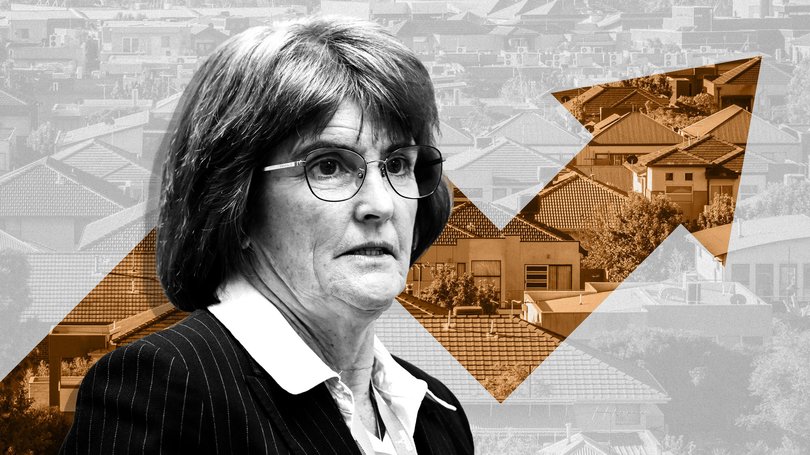Reserve Bank warns Labor’s first-home buyer scheme will push up house prices

The Reserve Bank of Australia today warned that Anthony Albanese’s plan to allow all Australians to purchase their first home with a 5 per cent deposit will push up prices, undermining one of the prime minister’s signature policies that comes into effect in nine days.
Governor Michele Bullock said not enough homes were being built to keep up with demand as families become smaller and fewer people live together, comments that may add to widespread scepticism about whether the Albanese Government can deliver the 1.2 million homes it has promised within five years.
“I think all estimates I’ve seen is that we are not,” she told a parliamentary committee in Canberra. “We’ve had declining household size over many, many years. If your average household size is declining, then you’ve got more demand effectively on the same stock of housing.”
Sign up to The Nightly's newsletters.
Get the first look at the digital newspaper, curated daily stories and breaking headlines delivered to your inbox.
By continuing you agree to our Terms and Privacy Policy.From October 1 people buying their first home will not have to pay the costly lenders mortgage insurance normally required of borrowers with an equity stake under 20 per cent. The government will guarantee the loans, a system designed to help people who would not have enough money otherwise to buy a house or apartment.
No limits
Unlike previous first-home buyer programs, there are no restrictions on the number of applicants or their incomes. The start date has been brought forward from January to October 1.
Cotality head of research Tim Lawless said less upmarket suburbs, including in growth areas such as outer Sydney, were likely to become even more unaffordable under the policy.
“It will put some upwards pressure on houses probably over a fairly short period of time until the more desirable suburbs rise above their pricing caps,” he told The Nightly. “That’s where demand is going to be most concentrated. There’s not many suburbs in say 20 kilometres of Sydney’s CBD where the median value falls below those price caps.”
Brad Jones, the central bank’s assistant governor for the financial system, said purchases were likely to accelerate for several years as buyers flooded the market.
“It will bring forward more purchases and increase the borrowing capacity of first-home buyers,” he said. “Our sense is that it could add to overall housing credit in the order of 1 to 2 per cent.
“At the very margin, you may see a little bit more upward pressure on house prices in the short-term, recognising that first-home buyers account for about 20 per cent of the flow of new housing credit.”
Going up
The price limit for the scheme in Sydney has been raised from $900,000 to $1.5 million. The limit for Brisbane was increased from $700,000 to $1 million in a city where mid-point house prices soared by 7.3 per cent in the year to August, Cotality data showed.
Melbourne’s limit goes up from $800,000 to $950,000. Adelaide’s limit is growing from $600,000 to $900,000 while Perth’s limit grows from $600,000 to $850,000.
Property in the south-west Sydney suburb Prestons has risen 10.7 per cent over the past year to $1.2 million, which is still well under the $1.5 million cap for greater Sydney.
“Detached houses in Sydney’s outer western suburbs are going to be quite popular,” Mr Lawless said. “It won’t take long for typical house values to rise above that $1.5 million cap. That’s where you’ll find demand is quite concentrated and in many ways, it’s first in, best dressed.”
Big banks’ bluff
The governor questioned threats by big banks to dilute fraud protection if the Reserve Bank reduces interchange fees, or what they pay Mastercard and Visa to do card transactions.
“I think it’s extremely unlikely that they’re going to shoot themselves in the foot by removing fraud protections or anything else like that,” she said. “Curtailing fraud protection to save money ultimately will not be good for them and it won’t be good for the payments system.”
She added loyalty points rather than fraud protection resources were affected in 2003 when interchange fees were first regulated.
“I would expect a very similar thing this time,” she said. “They are obviously looking for ways to push back on the reduction in interchange because that is revenue to issuers and so, in a sense, I don’t think that will happen, myself, but I understand why they are saying that.”
The Reserve Bank also wants to scrap surcharging, or additional fees on top of the wholesale cost of transactions which merchants can charge, which the banks are supporting.
Generational fairness
Ms Bullock, a mother of two, said she was worried about the next generation of Australians. “As a citizen, do I worry about intergenerational issues? Yes, I do. I have children,” she said. “But we at the Reserve Bank, we can’t impact this ourselves.”
She said that since the Global Financial Crisis of 2008 and 2009, Australia’s banks were more inclined to focus on home lending instead of business loans during a period of weak productivity growth and innovation.
“The Australian banks are very heavily weighted towards housing,” she said. “It’s favourably risk weighted and there’s a lot of demand for it. That’s why the banks have responded. It’s a result of the Global Financial Crisis where we tried to strengthen the banks and partly they’ve responded by directing financing to less risky things.”
The reluctance of banks to lend to businesses has also been linked with weaker innovation during an era of flat productivity growth.
“Australian businesses haven’t had the dynamism. We haven’t been sitting at the frontier, the innovation frontier. There’s plenty of evidence to suggest that we could do better and businesses could do better,” she said.
“It’s not just the role of government to look for productivity improvements. It’s also the role of business to look for productivity improvements.”
But she suggested artificial intelligence could be the answer to flatlining productivity in areas like finance.
“Ultimately, some of the AI developments might help in that particular sector.”

